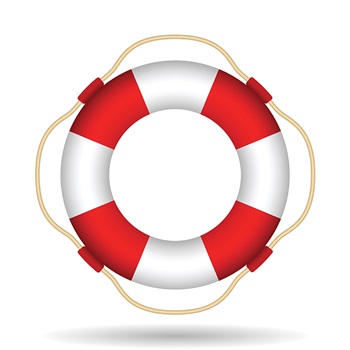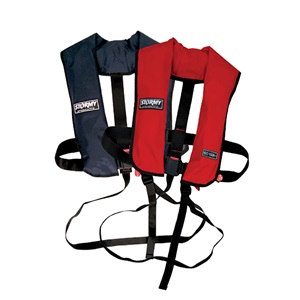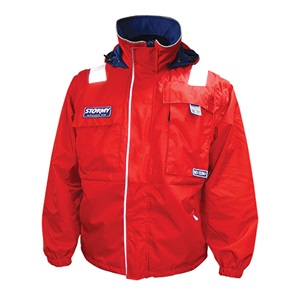Whether you call it a life jacket or a personal flotation device, an outlay of as little as $60 could save your life – but only if you wear it
By Catherine Norwood

Whether it is for work or recreation, your best personal flotation device (PFD) is the one you’re wearing when you find yourself in the water. That’s why comfort is one of the most important considerations when it comes to buying a PFD, says supplier Peter Campbell-Burns, who has been working in marine safety training and sales for more than three decades. “PFDs are only effective if you actually wear them,” he says, “and the more comfortable they are, the more likely they are to be worn.”
Advances in technology mean today’s PFDs are much smaller and lighter than the bulky foam-block life vests that were once the operating standard. As a director of Queensland’s MarineSafe Australia, Peter Campbell-Burns says inflatable PFD technology has taken over the market with its superior wearability and comfort. “Fifteen years ago, foam PFDs were 70 per cent of our sales,” he says. “Now that’s less than five per cent.”
Foam-style PFDs are still the only legal option for babies and children weighing up to 15 kilograms. For children weighing 15 to 40 kilograms automatic inflatable PFDs are the preferred option. In most instances, Australia wide, it is mandatory for children to wear a PFD at all times while on a boat.
Fit for purpose
Personal flotation device types
 Classic inflatable yoke-style PFDs
Classic inflatable yoke-style PFDs
Come in manual and auto-inflation with buoyancy rating of 150N. Price range $60-$250 Pictured: Stormy Life Vest Classic Inflatable RRP $120 (manual)  Vest-style PFDs
Vest-style PFDs
Come in a range of buoyancy ratings, manual and auto-inflation options. 100N is popular for activities such as rock fishing and kayaking. 150N is the minimum rating for open coastal waters. Higher ratings – 180N, 200N, 300N – provide additional buoyancy for equipment being carried. Prices range $150-$400 Pictured: Stormy Lite Pro Vest, 180N RRP $400  Jacket-style PFDs
Jacket-style PFDs
Suited for colder conditions, often with the option to unzip the sleeves, making the jacket a vest. Automatic inflation can be converted to manual and they can be fitted with strobe lights and personal location beacons. Price range $250-$700 Pictured: Auto-inflating Stormy Life Jacket, 150N RRP $399
PFD buoyancy is measured in newtons (N), which refers to the force of the ‘lift’ it offers. The Australian Standard for traditional foam PFDs is 87N. Gear with a rating of less than this is considered a ‘buoyancy aid’ suitable for someone conscious and capable of swimming, rather than a ‘flotation device’ suitable for non-swimmers or those who may be incapacitated.
International standards provide performance ratings of 100N, 150N and 275N for PFDs. Under the 2010 Australian Standard, a 100N or Level 100 PFD is the minimum requirement for offshore boating.
However, a 150N, or Level 150 PFD, is considered the buoyancy required to keep an unconscious person afloat. This is widely used both recreationally and commercially. Heavy-duty PFDs with a rating of 275N are designed for use in severe weather conditions and for those carrying equipment when they enter the water, such as water police or emergency rescue workers.
Buyers are offered a choice of automatic or manual inflation, and PFDs are generally fitted with a mouthpiece for manual inflation as well. Automatic PFDs have a water-sensitive spring-loaded device that triggers inflation. Manual PFDs require the wearer to pull on a tag to trigger the inflation. Automatic vests generally cost $30 to $50 more, but can usually be converted to manual operation and back again by the user if required.
Maintenance checks
Prices for inflatable PFDs range from $60 to $500 depending on the make and style, although maintenance requirements and the longevity of the product should also be considered in the cost of purchase. Some inflatable PFDs require servicing every year; others have a recommended two-year service regime.
Authorised service centres check the integrity of the seams and that a PFD can be inflated to the correct pressure. Peter Campbell-Burns says he has seen PFDs come apart during maintenance testing because the seams could not withstand the pressure of the gas during inflation. Servicing may also include checking that the accompanying gas cylinder is in good condition and matches the prescribed ‘full’ weight.
Location technology
Peter Campbell-Burns says while PFDs are the first line of defence in maritime and boating safety, location technology has an increasingly crucial role as it becomes more sophisticated, lightweight and affordable – starting at around $300.
Personal location beacons (PLBs) can be fitted into PFDs – they are now about the size of a highlighter texta and operate in a similar way to emergency position-indicating radio beacons (EPIRBs) used on vessels. Both systems use the international COSPAS-SARSAT satellite rescue data system to transmit signals to the nearest rescue centre, and the signal can be tracked to within three metres.
“We are selling more and more personal locator beacons all the time. They are on you, they are in your life jacket, and accurate to within three metres. There’s no reason for people to get lost any more, really,” he says.
Another option is an automatic identification system (AIS) man overboard device, which is a similar size to a PLB and uses the VHF radio system to send an emergency signal. These can be connected to an onboard chart plotter to locate a person who has fallen overboard, and can also be set to trigger an audible alarm on board. Peter Campbell-Burns says for those who do fall overboard: “Your best chance of survival is getting back aboard the vessel you’ve just come off.”
Standard approach
The Australian Maritime Safety Authority is standardising requirements for all commercial vessels, including those used in aquaculture, following the introduction of the national safety standards to replace state-based laws in 2013. However, regulations continue to differ from state to state when it comes to recreational boating.
Peter Campbell-Burns says wearing a PFD on the water at all times is the best option, particularly when there is a ‘heightened risk’. That includes whenever a vessel is “underway” as well as when anchored if weather warnings have been issued, when operating alone, or when visibility is poor.
The NSW Government is also moving to introduce compulsory wearing of PFDs for rock fishers. Legislation was proposed earlier this year, with 37 people reported to have drowned in NSW during the past four years after being swept from rocks while fishing.
Safety information
For more information on the wearing of PFDs and other safety requirements contact:
Australian Maritime Safety Authority
Marine and Safety Tasmania
Maritime Safety Victoria
NSW Roads and Maritime Services
Maritime Safety Queensland
Northern Territory Government
Western Australian Department of Transport
South Australian Government
Tragic headlines in 2016
Sunday 14 February
A 69-year-old man who was fishing alone only 50 metres from shore at Warrnambool died after his dinghy overturned.
The Standard, Warrnambool, Victoria
Wednesday 25 May
One man died and two others were injured when a six-metre, half-cabin boat capsized 1.5 kilometres off Bowen Harbour, at Bowen, south of Townsville, Queensland.
Daily Mercury, Queensland
Saturday 11 June
A 53-year-old man was reported missing after failing to return from rock fishing at Sydney’s northern beaches. A body found the following day was believed to be that of the missing man.
Sydney Morning Herald, New South Wales
Sunday 17 July
A 72-year-old man died after the 5.5-metre boat he and his son were fishing from capsized in the Gulf St Vincent, North Haven, South Australia.
ABC News, South Australia
Sunday 31 July
Four men on a recreational fishing trip were reported missing after launching from Cremorne Bay, Tasmania. The bodies of a 26-year-old, a 32-year-old and a 34-year-old man were recovered.
The Mercury, Tasmania
Wednesday 10 August
A 44-year-old diver failed to surface from a chartered diving trip to Henderson Rock off Moreton Island, Queensland. His body was recovered after an air and sea search.
Tweed Daily News, Queensland
Monday 15 August
A 40-year-old man was lost at sea after disappearing from a commercial crab-fishing vessel west of Steep Point, Denham, WA. A search was called off after police determined he was unlikely to have survived.
WAtoday.com.au, WA
Thursday 22 September
A 52-year-old crab fisher who set off from the Karratha Back Beach boat ramp was reported missing. His boat was recovered but the fisher has not been found.
Mandura Mail, WA





